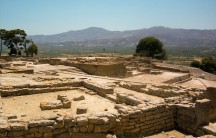Gorge of Ha
The gorge of Ha is a very particular feature of the geomorphology of the area. It is considered as one of the wildest gorges in Greece, a rare geological natural phenomenon, which could be the consequence of only one intrinsic factor, that of tectonic activity. p> Its name probably comes from the verb etymology “chasko” (which means “form a gap” in Greek). We could say that this is a pristine biotope, untouched by humans, since its geomorphology forbids everyone to make its acquaintance, cross it or exploit it.
The only people to have crossed it until today are three mountaineers from Thessalonica, well experienced and risky: Stavros Lazarides, Vlassis Chatzipanagiotou and Hronis Amatzides. To cross it, it took them a seven-days effort, that is from the 17th to the 23rd June 1987. A similar attempt from one who is not an experienced climber would be extremely dangerous. Actually, there are quite a few people who have tried to walk further into the ravine and the have risked or even lost their lives.
The entrance to the gorge it too narrow, approx. 3 metres, while upwards the opening widens. At many points, its width is just 30 centimetres and at some others it does not exceed three metres. On the right and on the left its huge walls rise at an altitude between 200 and 400 metres. Its length is approx. one kilometre.
Before the entrance, there is a little lake formed by a small waterfall, which is formed by another lake a little higher, not visible from the foot of the gorge. One can marvel it by climbing up the rocks carefully, on the left of the gap. The bedrocks are very impressive with their colourful striped patterns. In online casino the interior there are quite a few lakes forming waterfalls during the winter period. Then it is the most appropriate time to explore the gorge. Upon approaching the ravie, the visitor is overwhelmed with owe. Grey rocks, cut in square or rectangular shapes, rise majestically shading the small plane that spreads before them.
The area within the gorge and around is a significant biotope with lush flora and fauna. The small lakes constitute important wetlands for many migratory birds, as well as for the “permanent inhabitants”, which are some bird species and mammals. A few years ago, the mountain massif of Thrypti was verdant with high forest of pinus brutia pine trees and it was an ornament for all Crete. However, the greatest part of the forest was consumed through the great blazes of 1984 and 1987.The ability of the pinus bruta species to regenerate easily after each blaze would have ensured at least the partial remedy of the calamity in the forest, had there not been the incidence of illegal pasturing.
Besides pinus bruta, we encounter a multitude of trees and and bushes , herbs and flowers. Many rare and endangered plant species have found an ideal shelter inside the Ravine. In the surrounding area, there is a great array of birds, mammals, insects and reptiles However, while there is a significant number of species, on the other hand the number of the individuals for each species is limited, due to the destruction of biotopes mainly by human factors, such as hunting, especially during the night with the use of flashlights. Another destructive instance is traps or pesticides used in land farming.
Among the mammals, the prevailing species is the Cretan hare, the Cretan mink (kaloginekari) and the Cretan badger (arkalos). Moreover, populations of the spined mouse have been reported. It is a rodent that is not reported anywhere in Europe, since it constitutes a part of the African fauna. It resembles the common mouse, its hair is brownish with a white belly, yet it bears spines on its back and sides, like the porcupine. Porcupines are also reported in the area and they are protected by force of the Presidential Decree 67/1981, since populations are at stake due to pesticides and cars. Besides, several bat species live in the ravine of Ha.
The area of Thrypti is a natural habitat for many birds of prey, such as the bearded vulture, the griffon vulture, the golden eagle etc. Their population are diminishing continually, not only due to hunting and poisoned baits, but also because they face problems in their quest of food. What is more, smaller species have been registered in the area: kestrels (Falco Tinnunculus), choughs, jackdaws, carrion crows, red nightingales, grouses, quails, woodcocks and many migratory birds









